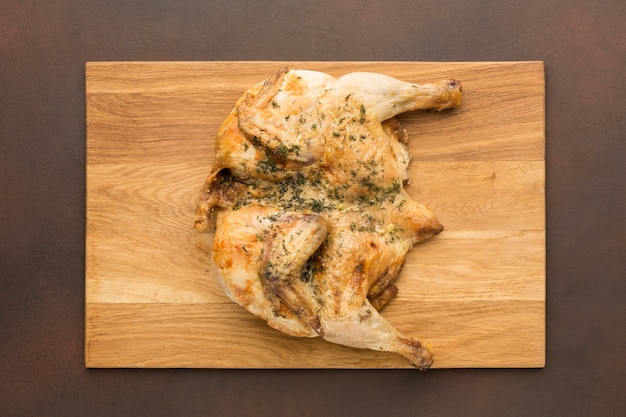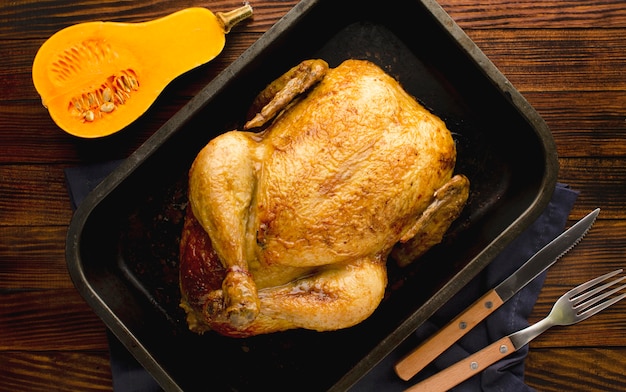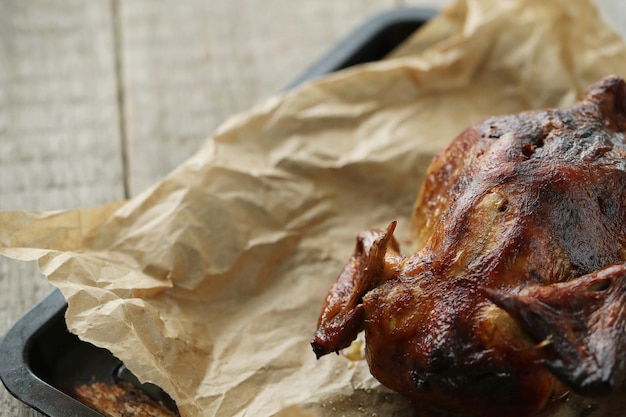Ah, roast chicken. Just the name conjures up images of golden-brown skin, juicy meat, and the comforting aroma of a hearty Sunday dinner. But let’s be honest, sometimes it can be a bit of a culinary gamble, right? One minute you’re picturing that perfect roast, and the next you’re dealing with dry, overcooked bits, or skin that stubbornly refuses to crisp up.
Well, fear not, my fellow chicken enthusiasts! This is your comprehensive guide to achieving oven-roasted chicken perfection. It’s packed with years of experience, a whole lot of trial and error, and a few tricks I've learned along the way. We’ll dive into everything from selecting the right bird to mastering the art of roasting. And don’t worry, I’ll even sprinkle in some of my favourite flavour combinations to get your tastebuds tingling. So grab a notepad, a glass of something refreshing, and let’s get cooking!
(Part 1) Choosing Your Chicken: The Foundation of a Great Roast

Before we even think about turning on the oven, we need the star of the show: the chicken itself. Now, you’ve got options here, from a majestic whole bird to individual pieces, or even those ever-so-versatile bone-in chicken breasts.
whole chicken: The Classic Choice
Personally, I’m a big fan of a good old-fashioned whole chicken roast. It just screams tradition, doesn't it? Plus, it's usually the most economical option, giving you plenty of meat to stretch across multiple meals.
Individual Pieces: For quick and easy meals
But if you’re short on time or just craving a faster meal, individual pieces are a great alternative. Think drumsticks, thighs, wings, or even breasts. They cook up faster and offer a lot of versatility.
Size Matters: Don’t Underestimate the Power of a Good Chicken
Remember, the size of your chicken is key. A smaller bird, around 1.5kg, will roast quicker than a larger one, say 2kg or more. I’ve learned the hard way that underestimating cooking time can lead to a dry, tough chicken. It’s always best to err on the side of caution, especially if you’re a little unsure.
Quality Counts: Supporting Local Farms and Butchers
Now, here’s a little tip that’s made a big difference for me: the quality of the chicken truly matters. I’m a firm believer in supporting local farms and butchers whenever possible. Their chickens tend to have a richer flavour and are often raised with a bit more care. But if you’re on a budget, supermarket chicken can still be good. Just look for a good colour, a plump appearance, and no signs of bruising.
(Part 2) Preparing Your Chicken: The Art of Getting Ready

Alright, we’ve got our chicken, now it’s time to get it ready for its starring role in the oven.
Patting Dry: The Secret to crispy skin
First things first, grab some kitchen paper and pat that chicken dry. It may seem like a small detail, but believe me, it makes a world of difference. Moisture on the skin prevents it from crisping up properly, and we all know that crispy skin is the best part, right?
Brining: A Secret Weapon for Tenderness
Here’s a little trick I’ve learned that truly elevates a roast chicken: brining. It's a simple process that adds flavour and keeps the chicken incredibly moist. You basically soak it in a salt water solution for a few hours before roasting. My go-to brine involves a mix of salt, sugar, and some aromatics like peppercorns or bay leaves. The salt draws moisture out of the meat, then pulls it back in, resulting in a tender, juicy chicken. But, brining is completely optional, so don't stress if you're not keen on it.
Seasoning with Love: A Symphony of Flavours
Now, it's time to season! This is where you can really unleash your creativity. I love a simple blend of salt, pepper, and maybe a touch of garlic powder. But, the sky's the limit. Herbs like rosemary, thyme, or oregano add a lovely freshness, while spices like paprika, cumin, or coriander bring warmth and complexity. Don't be afraid to experiment and find what you love!
Getting that Perfect Skin: Achieving Ultimate Crispness
To really boost that crispness, rub the chicken with a bit of oil. Olive oil is my favourite, as it adds a lovely flavour and helps the skin get that golden-brown perfection. A squeeze of lemon juice or a splash of vinegar can also add a beautiful tang.
(Part 3) The Roasting Technique: A Step-by-Step Guide

We’ve prepped our chicken, now it’s time to put those roasting skills to the test!
Temperature is Key: Finding the Sweet Spot
Preheat your oven to around 200°C (400°F). Through a lot of experimentation, I’ve found this temperature to be the sweet spot for a good balance of browning and cooking time.
Don’t Overcrowd the Oven: Give Your Chicken Space
Don’t cram that chicken into a tiny oven. It needs to circulate properly for even cooking. If you’re roasting a whole chicken, use a roasting tin big enough to fit it comfortably.
The Chicken’s Best Friend: The Roasting Rack
Here's a little tip passed down from my mum: use a roasting rack! It lets hot air circulate all around the chicken, resulting in crispy skin and perfectly even cooking. If you don't have a rack, place the chicken on some sliced vegetables like carrots or onions. They'll add flavour and keep the chicken elevated.
Don’t Forget the Basting: A Little TLC
Throughout the cooking process, you’ll want to baste the chicken with the pan juices. This keeps it moist and adds flavour. You can use a spoon or a basting brush. Just be careful, those pan juices can be hot!
Checking for Doneness: The Moment of Truth
This is a crucial step. You need to check if the chicken is cooked through. The best way is to use a meat thermometer. Ensure the internal temperature reaches 74°C (165°F). Or, you can pierce the thickest part of the thigh with a skewer. If the juices run clear, it’s cooked.
Rest Time: Patience is Key
Once the chicken is cooked, let it rest for 10-15 minutes before carving. This allows the juices to redistribute, ensuring a moist and tender bird.
(Part 4) Flavour Combinations: Beyond the Basics
Alright, we've got the technique down pat, now let's explore some delicious flavour combinations to take your roast chicken to the next level!
Roast Chicken with Lemon and Herbs: A Classic with a Twist
Let’s start with a classic that never fails: lemon and herbs. Rub the chicken with a mixture of olive oil, lemon juice, and fresh herbs like rosemary, thyme, and oregano. It’s simple, fragrant, and always a crowd-pleaser.
Honey Garlic Roast Chicken: Sweet and Savoury Perfection
Another favourite in my kitchen is honey garlic roast chicken. It’s sweet, savoury, and utterly delicious. Simply mix some honey, soy sauce, garlic, and ginger together, then brush it all over the chicken. It pairs beautifully with roasted vegetables like carrots, potatoes, and onions.
Spiced Roast Chicken with Curry Powder: A Touch of Adventure
Feeling adventurous? Try spiced roast chicken with curry powder. Mix a generous amount of curry powder with paprika, cumin, and a bit of turmeric, then rub it all over the chicken. You’ll get a beautifully golden and flavourful roast.
Roast Chicken with Dijon Mustard and Herbs: A Tangy Delight
If you like a bit of tang, try roast chicken with Dijon mustard and herbs. Mix some Dijon mustard with olive oil, fresh thyme, and rosemary. A pinch of garlic powder adds another dimension of flavour. The mustard brings a lovely sharpness, while the herbs create an irresistible aroma.
(Part 5) Serving Suggestions: Completing the Feast
Okay, we’ve got our perfectly roasted chicken, now it's time to think about the sides!
Roast Chicken with All the Trimmings: A Traditional Feast
You can go for the classic roast dinner combo: roasted potatoes, carrots, parsnips, and gravy. It's a timeless combination that never disappoints.
Creative Sides: Exploring Flavour Combinations
Or, get a bit more creative with roasted vegetables like asparagus, broccoli, or Brussels sprouts. I love to add a vibrant salad to the side, something with mixed greens, tomatoes, and a tangy dressing.
Delicious Leftovers: Making the Most of Your Roast
And don’t forget about the leftovers! They’re just as delicious as the first time around. You can shred the chicken and use it in salads, sandwiches, or soups. Or, simply reheat it and enjoy it with some mashed potatoes or rice.
(Part 6) Tips and Tricks: Mastering the Art of Roasting
Now, here are a few more tips and tricks I've picked up along the way.
Don’t Be Afraid to Get Messy: Embrace the Cooking Process
Let’s be honest, roasting chicken can be a bit messy, but that's just part of the fun. Just make sure you’ve got a good oven mitt and some kitchen paper handy to clean up any spills.
Cooking Time Varies: Checking for Doneness
Remember, cooking times can vary depending on the size of your chicken and the oven you're using. Always check the chicken's internal temperature to ensure it’s cooked through.
Adding Flavour to the Pan: Infusing with Aromatics
To add extra flavour to your roast chicken, place some aromatics like onions, garlic, or herbs in the bottom of the roasting tin. These will infuse the chicken with their flavour as it cooks.
(Part 7) Troubleshooting: Solving Common Roasting Challenges
Okay, so your chicken turned out a bit dry, or the skin didn’t crisp up as you hoped. Don’t worry, it happens to the best of us! Here are a few solutions to common roasting challenges:
Dry Chicken: Tips for Moisture
You can try using a meat thermometer to ensure you're not overcooking it. Also, try basting the chicken more frequently to keep it moist.
Skin Not Crispy: Achieving That Golden Brown
Try patting the chicken dry before roasting, and using a roasting rack to allow for better airflow. You can also try raising the oven temperature slightly in the last 15 minutes of cooking to encourage browning.
Burnt Chicken: Avoiding Disasters
Use a lower oven temperature, and watch it more closely during the last part of the cooking time. You can also cover the chicken with foil for the first part of the roasting, then remove it for the last 30 minutes to allow the skin to crisp up.
(Part 8) FAQs: Addressing Your Questions
Here are answers to some common questions about roasting chicken:
Q: Can I freeze roasted chicken?
A: Yes, you can freeze roasted chicken, but it’s best to freeze it before it's been reheated. To freeze, let the chicken cool completely, then wrap it tightly in plastic wrap and then in aluminum foil. It can be frozen for up to 3 months.
Q: How do I reheat roasted chicken?
A: You can reheat roasted chicken in the oven, microwave, or on the stovetop. For oven reheating, preheat your oven to 175°C (350°F) and heat the chicken for about 20-30 minutes, or until heated through. For the microwave, cover the chicken with a damp paper towel and microwave on high for 1-2 minutes per piece. For the stovetop, heat the chicken in a skillet with a little oil over medium heat for about 5-7 minutes, or until heated through.
Q: What can I do with leftover roasted chicken?
A: There are endless possibilities for leftover roasted chicken! You can shred it and use it in salads, sandwiches, soups, or tacos. It’s also delicious in pasta dishes, casseroles, or even as a topping for pizza.
Q: Can I roast chicken with vegetables?
A: Absolutely! Roasting chicken with vegetables is a great way to create a complete meal. Just make sure to choose vegetables that cook at a similar rate as chicken, such as carrots, potatoes, or onions. You can also add other vegetables like Brussels sprouts, asparagus, or broccoli in the last 30 minutes of cooking.
Q: How long does it take to roast a chicken?
A: The cooking time for a whole chicken will vary depending on its size and the oven temperature. However, a general rule of thumb is to allow about 20 minutes per pound, or 45 minutes for a 2-pound chicken. Always use a meat thermometer to check the internal temperature to ensure the chicken is cooked through.
Everyone is watching

Prime Rib Roast Cooking Time Chart: Per Pound Guide
Cooking TipsPrime rib roast. Just the name conjures images of lavish dinners, crackling fires, and hearty laughter. It’s ...

How Long to Bake Potatoes in the Oven (Perfect Every Time)
Cooking TipsBaked potatoes are a staple in my kitchen. They're incredibly versatile, delicious, and surprisingly easy to m...

Perfect Rice Every Time: The Ultimate Guide to Cooking Rice
Cooking TipsAs a self-proclaimed foodie, I've always been a bit obsessed with rice. It's the foundation of countless cuisi...

The Ultimate Guide to Cooking Asparagus: Tips, Techniques, and Recipes
Cooking TipsAsparagus. The mere mention of this spring delicacy conjures up images of vibrant green spears, crisp and burs...

Ultimate Guide to Cooking the Perfect Thanksgiving Turkey
Cooking TipsThanksgiving. Just the word conjures up images of overflowing tables laden with delicious food, the scent of r...
